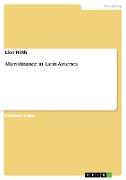- Start
- Microfinance in Latin America
Microfinance in Latin America
Angebote / Angebote:
Seminar paper from the year 2006 in the subject Economics - Finance, grade: 1, 0, University of Massachusetts - Amherst (Department of Economics), course: Wirtschaftliche Entwicklung - Economic Development, 31 entries in the bibliography, language: English, abstract: Rewarding the Nobel Peace Prize to Muhammad Yunus, the committee acknowledged that microfinance is the latest fashion of both development policy and development economics, some call it even a "popular mass movement" (Woller et al. 1998). Indeed, the development over the last 30 years is impressive: Today, more than 100 million poor have access to small loans. While the formal financial sector perceived financial services to the poor "unimportant for the economy, unprofitable for financial institutions, and unnecessary for the poor", modern microfinance institutions (MFIs) have proven that high recovery rates do not depend mainly on circumstances and the characteristics of the borrower, but on the design of the credit program: "repayment depends fundamentally on factors within the control of the lending institutions" (Robinson 2001).
This paper gives a short overview about the roots of modern microfinance and its global history. Some central theoretical aspects of financial markets are discussed and the main innovations of modern microfinance are presented. Focusing on Latin America, the paper shows that microfinance is booming on the continent. While Village Banks, focused on the poor, are still growing, a larger trend goes towards commercialization, including the entrance of established banks to the market. It seems quite clear that these banks reach even less of the poorest than not for profit NGOs do. More disturbing, there is little empirical evidence that microfinance can help many poor people in Latin America. The role of microfinance in the overall development progress is small at best.
Folgt in ca. 5 Arbeitstagen
